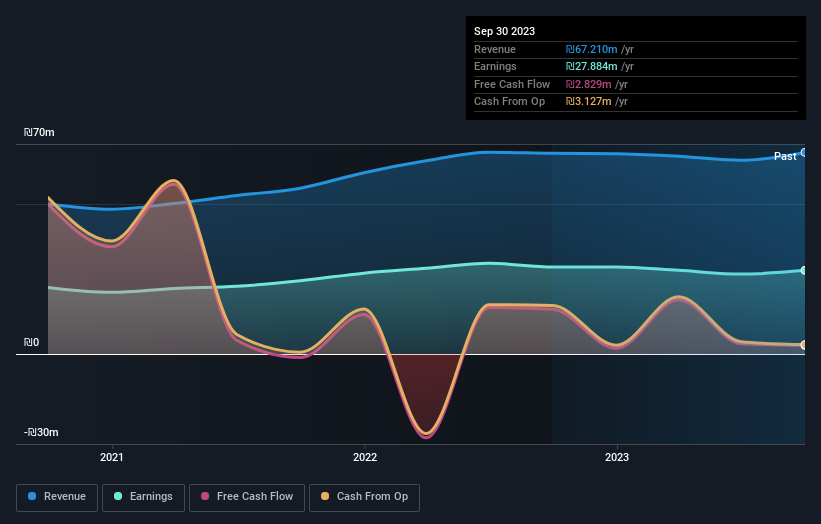Stock Analysis
- Israel
- /
- Diversified Financial
- /
- TASE:OPAL
While shareholders of Opal Balance Investments (TLV:OPAL) are in the red over the last three years, underlying earnings have actually grown

While it may not be enough for some shareholders, we think it is good to see the Opal Balance Investments Ltd (TLV:OPAL) share price up 27% in a single quarter. But that doesn't help the fact that the three year return is less impressive. After all, the share price is down 43% in the last three years, significantly under-performing the market.
The recent uptick of 21% could be a positive sign of things to come, so let's take a look at historical fundamentals.
Check out our latest analysis for Opal Balance Investments
To paraphrase Benjamin Graham: Over the short term the market is a voting machine, but over the long term it's a weighing machine. One way to examine how market sentiment has changed over time is to look at the interaction between a company's share price and its earnings per share (EPS).
Although the share price is down over three years, Opal Balance Investments actually managed to grow EPS by 6.5% per year in that time. This is quite a puzzle, and suggests there might be something temporarily buoying the share price. Or else the company was over-hyped in the past, and so its growth has disappointed.
It's worth taking a look at other metrics, because the EPS growth doesn't seem to match with the falling share price.
Given the healthiness of the dividend payments, we doubt that they've concerned the market. It's good to see that Opal Balance Investments has increased its revenue over the last three years. But it's not clear to us why the share price is down. It might be worth diving deeper into the fundamentals, lest an opportunity goes begging.
The image below shows how earnings and revenue have tracked over time (if you click on the image you can see greater detail).

Take a more thorough look at Opal Balance Investments' financial health with this free report on its balance sheet.
What About Dividends?
When looking at investment returns, it is important to consider the difference between total shareholder return (TSR) and share price return. Whereas the share price return only reflects the change in the share price, the TSR includes the value of dividends (assuming they were reinvested) and the benefit of any discounted capital raising or spin-off. Arguably, the TSR gives a more comprehensive picture of the return generated by a stock. We note that for Opal Balance Investments the TSR over the last 3 years was -33%, which is better than the share price return mentioned above. The dividends paid by the company have thusly boosted the total shareholder return.
A Different Perspective
It's good to see that Opal Balance Investments has rewarded shareholders with a total shareholder return of 36% in the last twelve months. Of course, that includes the dividend. That certainly beats the loss of about 4% per year over the last half decade. This makes us a little wary, but the business might have turned around its fortunes. It's always interesting to track share price performance over the longer term. But to understand Opal Balance Investments better, we need to consider many other factors. For instance, we've identified 4 warning signs for Opal Balance Investments (1 shouldn't be ignored) that you should be aware of.
If you are like me, then you will not want to miss this free list of growing companies that insiders are buying.
Please note, the market returns quoted in this article reflect the market weighted average returns of stocks that currently trade on Israeli exchanges.
New: AI Stock Screener & Alerts
Our new AI Stock Screener scans the market every day to uncover opportunities.
• Dividend Powerhouses (3%+ Yield)
• Undervalued Small Caps with Insider Buying
• High growth Tech and AI Companies
Or build your own from over 50 metrics.
Have feedback on this article? Concerned about the content? Get in touch with us directly. Alternatively, email editorial-team (at) simplywallst.com.
This article by Simply Wall St is general in nature. We provide commentary based on historical data and analyst forecasts only using an unbiased methodology and our articles are not intended to be financial advice. It does not constitute a recommendation to buy or sell any stock, and does not take account of your objectives, or your financial situation. We aim to bring you long-term focused analysis driven by fundamental data. Note that our analysis may not factor in the latest price-sensitive company announcements or qualitative material. Simply Wall St has no position in any stocks mentioned.
About TASE:OPAL
Opal Balance Investments
Provides various financing services mainly to small and medium-sized businesses in Israel.
Good value with mediocre balance sheet.

